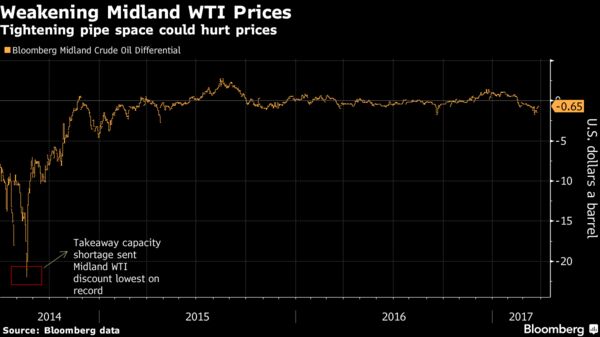West Texas Intermediate crude at Midland, Texas, the heart of the Permian Basin, sank this month to the lowest level since September. It’s the weakest for this time of year since 2014, according to data compiled by Bloomberg. That year, the discount versus the same oil in Cushing, Oklahoma, the U.S. benchmark, plunged to $21 in August as the shale boom flooded the region with oil, Bloomberg reported.

Permian output is expected to rise to 2.65 million barrels a day in December, said William Foiles, an oil analyst with Bloomberg Intelligence. In comparison, takeaway capacity in the region may only reach 2.54 million barrels a day by end of this year, according to Bloomberg Intelligence pipeline analyst Michael Kay.
While Midland prices probably won’t reach 2014 levels, they could fall to $5 a barrel below WTI at Cushing later this year, “because of tightness in takeaway capacity in the Permian,” Paul Grigel, Denver-based analyst at Macquarie Capital USA Inc., said by phone.
Pipeline operators are looking to increase capacity on existing lines to meet the increased output. A plan by Enterprise Products Partners, LP to start up a new Midland to Sealy, Texas, pipeline is expected to begin service in the fourth quarter, but its full capacity of 450,000 barrels a day would only be available in early 2018, Kay said, referring to an Enterprise presentation.
“From the looks of it there could be several thousand barrels a day worth of midstream capacity shortages by the end of the year,” Mara Roberts, a New York-based analyst at BMI Research, said in a phone interview. “The rate of growth in takeaway pipeline capacity is going to be where the bottleneck is, and that will choke access to the market for producers.”
Permian producers will also come up against rising U.S. stockpiles, particularly in Cushing, the nation’s largest commercial storage depot. Inventories at Cushing, at almost 68 million barrels, are hovering near a high not seen in nearly 10 months, according to the EIA.
Potential relief for Permian pipeline takeaway capacity might be on the way in 2019. The EPIC pipeline is in the middle of an open season to gain shipper commitments for its proposed 440,000 barrel a day pipeline that would stretch from the Delaware and Midland basins in West Texas to Corpus Christi, Texas. The project, co-owned by TexStar Midstream Logistics, Castleton Commodities International LLC and Ironwood Midstream Energy, will only go forward if they secure enough commitments from shippers.
“To really put the market at ease it would take a new pipeline. But even then we won’t see Midland discounts going to $20 in 2017,” Grigel added.

